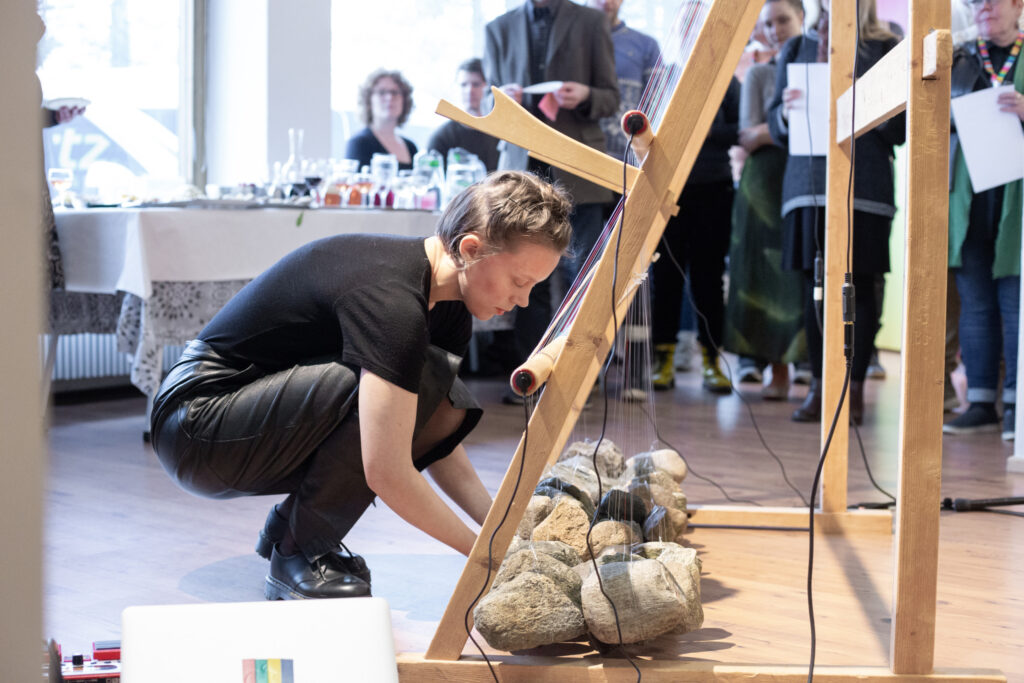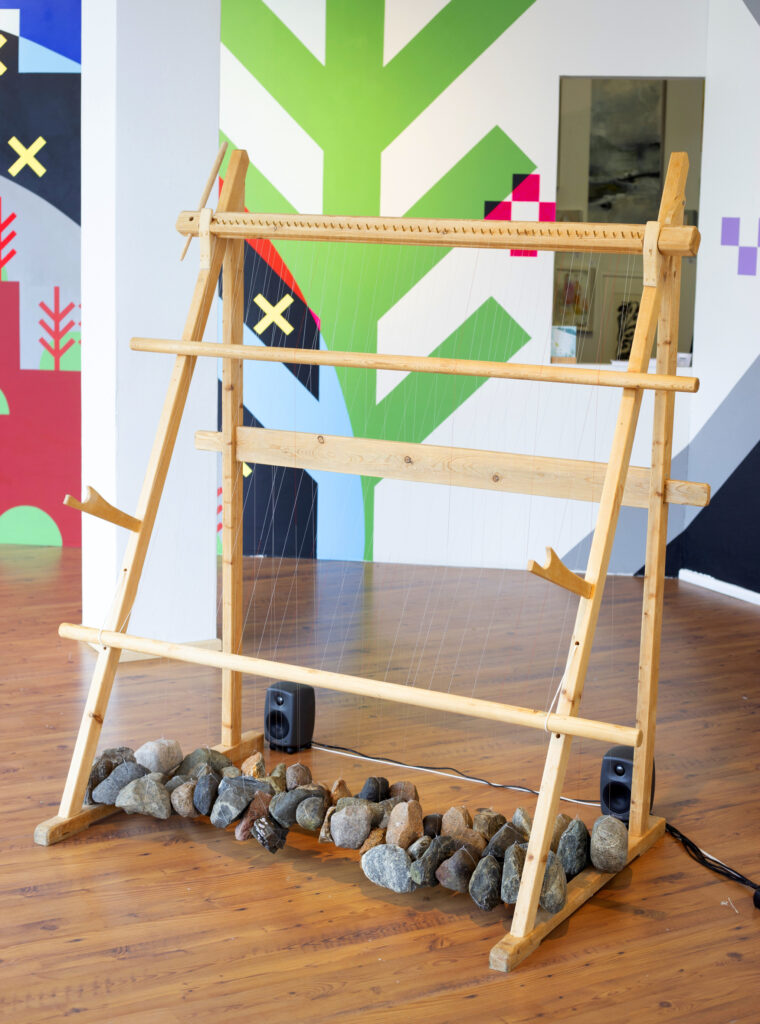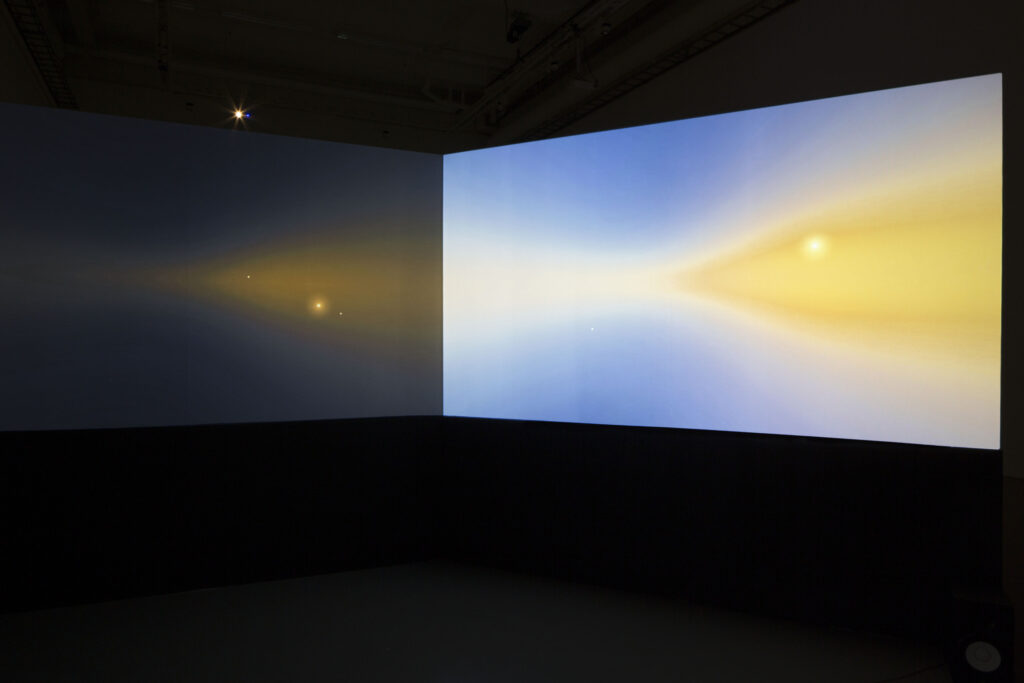This writing was originally made as an introduction to some of the works in the 2019 Young Arctic Artists Exhibition. I curated the exhibition together with Ninni Korkalo. The text was originally published at Post Santa blog, an art blog which is run by the Artists ́ Association of Lapland.
Curator Panu Johansson’s thoughts about the media art pieces in the Young Arctic Artists exhibition of 2019.
The third incarnation of The Young Arctic Artists exhibition is currently displayed in Gallery Napa and Studio Mustanapa in Rovaniemi, Finland. The theme for this year’s exhibition is the Transmission of Knowledge and the show contains works from altogether eight artists around the Northern Hemisphere. The exhibition has been curated by yours truly in cooperation with Ninni Korkalo. In the following writing I will introduce some of the media artworks of the exhibition. Simultaneously I’ll try to open up their background slightly and also present some of the thoughts they have managed to provoke.
The first piece of the exhibition greets the spectator already before arriving to the gallery space. Norwegian artist Guro Rex’s video work The Universe Is Da Club is displayed on the gallery window. Short video loop documents an event where a young woman, dressed in the Norwegian national costume, pops up a bottle of champagne. What pops up on the screen after this, is the title of the piece on cheesy gradient letters. It feels almost as if the piece is asking: Are you glad to be alive today? Maybe you should, ‘cos this particular space and time, this cosmos, is the place to be.
The world of Guro Rex continues downstairs in the first room of Gallery Mustanapa. Firstly the space contains a monitor, where several videoworks are running on a loop. Secondly, on the walls there are a few examples of a somewhat autobiographical email project that the artist is running. And most importantly, this project is something that everyone can participate in. All you need to do, is send a message saying ‘what is love baby don’t hurt me’ to 1212cow.pony@gmail.com and voilà – you will soon start to receive gallery spaces right in to your inbox!
The same personal voice of the author can be heard in the presented videoworks. They are an interesting mixture of just about everything, as if they were results of continuous creative explosions. As a spectator they make you anxious: you have a feeling nearly anything could follow. The colourful mixture of numerous elements create associations towards Jacolby Satterwhite and the continuous poses maybe a hint of Pipilotti Rist, but above all these works seem to be influenced by the current world of online videos on social media.
The ingredients of the videos are familiar, but they are somehow exaggerated so that the result becomes completely overloaded – and fun. The hand-held camera seems to suffer from a chronic shiver, images are transitioned with a very lofi pixelated crossfades and somewhat unrelated clip art animation loops just keep on appearing. Fairly cheap looking background templates are also in frequent use. The videos are mostly concentrated on a person or two, who speak or perform straight to the camera. Sometimes the outcome resembles a video diary, other times a performance. Expressions are unashamedly overstated and voices are often pitched either helium high or extremely low. The chit-chat rolls around topics we all know, from various ”projects” to why ”I’m better than him, they just haven’t discovered me yet”.
As mentioned, these elements are something that we all know, but it’s also important to emphasise that these videos are not plain parodies, nor critique. They clearly benefit from being exhibited in large numbers, because this way it becomes obvious that they are rather parts of the personal expression – or dare I say universe – that the artist has created. Of course it easy to draw links and connections to many directions. For example, one could say that these videos reflect how the artist is looking at our own time through a distinctive prism and simultaneously manages to capture something that is culminating right now. This could very well be the case and that might partially create their charm. One the other hand, their appeal may simply come from the fact that this universe actually is _the_club– and nuff said with that!
The Norwegian Sámi artist Elina Waage Mikalsen presents a piece called “Mun bijan iežan beallji ránu beallji vuostá / I put my ear next to the looms ear” in the exhibition. The author defines the work as a sonic loom and that is indeed quite an apt description. During the exhibition the actual piece is displayed in two different contexts. First Waage Mikalsen performed with the piece at the exhibition opening and throughout the rest of the exhibition period the piece is displayed with a running audio loop that was recorded from this performance. Both forms also stand independently on their own feet, hence you can enjoy the exhibited piece without seeing the opening performance.

The artefact of the piece is an old loom that used to belong to the author’s grandmother. For the piece the artist has modified the old device in a way that it has become something completely else: an instrument. Where there used to be weft threads, there are now strings. These strings are then bent with rocks whose weight tightens them and makes them playable. During the performance Waage Mikalsen also placed several mics around the object to capture the sound of the strings but also the resonances, tones and noises from the object itself. Further on, these sounds were yet modified with electronic effects.

The cultural background of the piece lies in the Sea Sámi culture around the area of Olmmáivággi/Manndalen, where the author’s Sámi roots are located. This area has maintained a rare handicraft tradition of vertical loom, which is the type the loom of the piece also represents. These looms are used to weave multipurpose textiles called as rátnu. Previously used in various purposes in everyday life, today these textiles are more of a decorative. The making these handicrafts was traditionally concerned to be an area of women, and they were sometimes made also together in groups.
The audio of the piece lasts about ten minutes. It starts off with clacks of wood and scraping of the strings. Delay and reverb are apparent right from the start as well. As the works moves ahead, slowly but steadily more and more electronic particles start to appear in the sonic architecture. At one point the strings really start to vibrate and the intensity clearly grows. Banging of the stones can also be heard in the background.
During the last minutes of the audio the author’s own singing voice sneaks in to the aural landscape. Do you know the moment when a piece all of a sudden comes beautifully together – when all just clicks? With this work, this is that moment. It is intriguing how this one additional element turns out to be the last piece of the puzzle, that nails the whole. The presence, that is already in the piece, suddenly becomes somehow audible, materialises. But whose presence is that? Is the voice a howl through times, from the past to the present? Or is it the other way around – from here to there? Or perhaps it’s both at the same time? In any case one could say that in the piece several elements and their presence overlap in a natural, unforced way. That is: the presence of the author at this time and the strong presence of the history through the artifact. Thirdly there is the soundscape which reflects both today and the past and thus ties these two delightfully together.
Overall, the associations that the works creates in different directions are compelling. Bent strings of course point towards the world of traditional tonal music. When listening the piece, particularly Finnish group Memnon comes to my mind. However, to be precise this piece is not about that. It is neither a collage nor musique concrète which use old archival recordings to create new entities. Nor is it the type of experimental music, which is based on sole experimenting with the technology. Instead of all this this, I would say that this piece is a fascinating effort to interpret the material culture of the past and a soundscape related to it in a completely new way – to put one’s own ear carefully against the loom’s ear – and place it in the new framework of contemporary art.
Guro Rex’s pieces are not the only ones located in the Gallery Mustanapa. The large backroom of the gallery contains a two channel video installation In Silico by Laura Heuberger, who is a Swiss/Italian artist currently living in Northern Sweden. The title of the piece is an expression, which means “performed on a computer” or “via computer simulation”.

The piece starts off with a monologue that addresses someone, perhaps the spectator, straightforwardly. The voice is soft and gentle, although the timbre sounds slightly like a machine:
“Hi. Please make yourself comfortable…I never know what to say in these situations. I’m very quiet sometimes. I’d usually rather listen…What’s the best icebreaker you’ve heard? Once, I had someone approaching me with one of those very cheesy pickup lines. It was so weird…I like traveling, seeing new places, meet new people…But it’s been a while ago. Now I’m here.”
As the piece advances the viewer travels through different micro- and macrocosms on the screens. Visions that unfold could be sometimes interpreted as pulsating stars and planets orbiting in space, other times as bustling bacteria and other microorganisms under a microscope. The flow of water or other liquid is also a reoccurring theme. The images are accompanied by occasional glimpses of peaceful ambient soundscapes.
On the audio track the aforementioned chat evolves into a long string of topics that reminisce old childhood memories, personal diary notes and philosophical pondering about the nature of existence. But not without interruptions. What takes turns with the gentle voice number one in the audio track, is a second voice, which is clearly synthetic. With a very dull intonation this second voice goes through conditions and details, which would allow a human mind to be simulated. In contrast to the previous personal touch, the overtone of the second voice is clearly formal and academic. That is not a surprise, since the parts spoken by this voice no.2 have been quoted from the article Are You Living in a Computer Simulation? by the Swedish philosopher Nick Bostrom.
What Bostrom is claiming in the article has become known as the simulation argument. Basically what he is saying is, that in the future as the computing power increases the simulation of the human brain might be possible. Bostrom does not claim that we are currently living in a simulation. However, he argues that there are three different unlikely scenarios, out of which one is almost certainly true:
- 1. Mankind will never evolve to a level where human mind can be simulated.
- 2. Or then it does, but for some reason – such as ethical or simply a lack of interest – this kind of technology will never be taken in use.
- 3. Or, we are currently living in a simulation.
The idea that the whole reality as we perceive it is just an illusion, is of course not new. Already Plato presented The Allegory of The Cave that aptly demonstrates how our view of the existence could be only one out many possible. Also the Chinise philosopher Zhuangzi has introduced the famous dream argument, which has also been called “The Zhuangzi Paradox”. According to it we can’t really say weather the whole reality is actually just a dream or not. The idea of the reality being simulated or otherwise artificial is also a common theme in Sci-Fi. Already in 1977 Philip K Dick presented that we are living inside a computer simulation. Still, I would say that the modern simulation theories are simply mind boggling.
If the reality around us can be just a simulation or a dream, how do we truly know what’s real? I guess the answer is, that we profoundly don’t. But on the other hand: if something feels real, isn’t it real – even at some level? And what is “real” anyway – how do you define it? What is the opposite of real? False, unreal, bogus or artificial? Are the stories in the piece real? Does it matter?

One of the biggest merits of In Silico is pointing out the vagueness of the border between something authentic and synthetic, real and unreal. It is almost impossible to define it – let alone in a universal way. Another important question that the work touches is the way we are accustomed to outline the situation. You have to be this or that: true or fake. Is this kind of starting point – a dichotomy – even a valid way to describe the actual situation? When talking about simulated reality, most people will probably go over to top and think of something like The Matrix. If something like this is even remotely the case, is a completely different thing. More probable is that this kind of simple reality/illusion juxtaposition is a man made concept. The validity of our reality can certainly be questioned, but a good way to begin the process might be to concentrate on our start off assumptions first.
